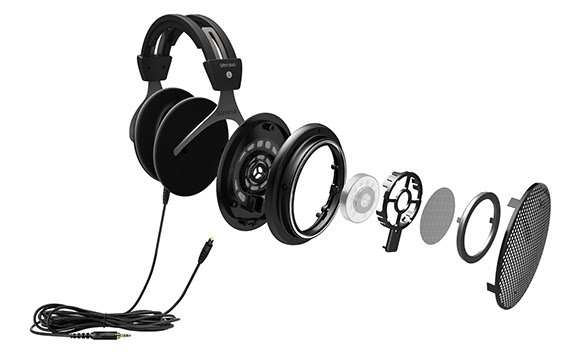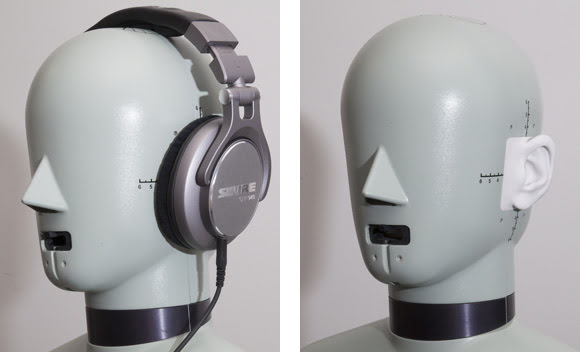What practical information could be offered in helping them make the best choice? We like to explode myths – were there any here?
We decided to get the scoop from Principal Engineer Yuri Shulman, a 32-year veteran of Shure® who leads the development of Shure’s growing product line. We chatted about sound signatures, frequency response and even touched (very lightly) on the science of psychoacoustics.
What can you tell us about frequency response?
What can you tell us about frequency response? Isn’t there a sense that a flat frequency response is preferable to a more shaped sound? Frequency response has a strong effect on perceived timbral quality and is, therefore, an essential component in high-quality headphone design. The issue goes back to the loudspeaker industry where a flat response (when a speaker’s acoustic output stays the same for every frequency) is usually preferred. However, there is a major difference between acoustic measurements made on loudspeakers and headphones.While a loudspeaker frequency response can be evaluated in free-field conditions, headphones have to be coupled to the ear if a frequency response measurement representative of what listeners perceive is intended. This requirement implies that the ear must be included in the measurement system. Several methods have been used to take the ear into account. These include the perceptual loudness comparison as well as instrumental measurements made with artificial ears and couplers. In the headphone measurement techniques, the resulting frequency response includes the filtering effect of the listener’s ear, and therefore the reference of a flat frequency response no longer applies in this context. Instead, the target headphone response is designed to provide a ‘natural’ listening experience, similar to one received while listening with flat loudspeakers in the ‘sweet spot’ in the room.
While a loudspeaker frequency response can be evaluated in free-field conditions, headphones have to be coupled to the ear if a frequency response measurement representative of what listeners perceive is intended.
Many of our headphones are designed to be perceived as flat. They deliver naturally balanced, non-equalised sound. Of course, there are special user situations when deviation from a perceived flat frequency response is desired.

So, the actual differences in the structure of a listener’s ear have an impact on user preferences?
It’s difficult to design something that will sound perfect to everyone – in fact, it’s impossible, and yes, that’s based, in part, on the actual physical characteristics of the listener’s ear. When designing Shure headphones, we use industry standard ear simulators that represent an average human ear. Its physical characteristics are based on carefully measured ears. There can, however, be significant deviations from this standard ear in some individuals. In addition, personal taste is also a factor in user preferences.When is a flat response preferred?
Someone who is recording or mixing needs to hear every component in the sound spectrum with full resolution and high timbral accuracy, so it’s important to have a tool that’s neutral in character.Enhanced low frequencies could compensate for lost sound pressure effects on the body such as bone/chest transmission and nasal cavity compression.
When would a shaped response headphone be used?
For example, accurate sound reproduction is not of concern for DJ headphones. These are designed to provide enhanced, strong, low frequencies and crisp highs. It’s the kick drums, snares, and hi-hats you’re paying attention to when mixing, not intricate sonic details.
Here’s something we hear pretty often: headphones require a ‘burn in period’. Is this true?
This is more myth than fact. Some people make the argument that the driver suspension could be a little unsettled when the headphones are brand new.
At Shure we don’t subscribe to that thinking – again, what could be true for some loudspeakers (where there can be a 100-hour or so burn-in period) doesn't directly apply here.
It’s a matter of perception. Shure headphones sound the same after using them for a year as they did brand new.
If everyone hears differently depending on the physical shape of their ears, their hearing abilities (and even right ear/left ear hearing differences), how is it possible to develop standards when you beta-test headphones?
Here, for example, is one of our techniques: we utilise the Head and Torso Simulator (HATS) when developing headphones. We use outer silicone ears of different sizes and densities with artificial inner ears that match the impedance of the average human ear. We measure the headphone’s actual performance affected by resonance in the ear canal and shape of the ear. Data is collected and used to engineer the response of each model to produce a flat or other desired frequency response profile as perceived by the ‘average’ listener.
Of course, we also beta-test with trained human listeners – both audiophiles and professional sound engineers. While professional users look for a perfectly flat, smooth spectral balance and highest possible detail resolution, the audiophiles are more concerned with musicality or ability of the headphones to communicate the musical message as it was intended by the performers. Harmonic and intermodulation distortions, fatigue factor and wearing comfort are also graded by both groups of beta testers.

Enhanced bass seems to be a trend with consumer headphones, correct?
Yes, some popular consumer headphones have dramatically enhanced bass response. However, this excessive correction leads to increased distortions and added listening fatigue. Actually there may be good reasons to enhance low-frequency response on certain headphones assuming this is done correctly, and responsibly. Let me give a few examples where such enhancement could be of benefit:
- Listening at very low levels would benefit from boosted bass according to the equal-loudness curves (Fletcher-Munson). Our ears are less sensitive to low frequencies as listening volume decreases
- Listening on the subway train or city bus – increased output of low-frequencies will help to mask outside noise for a better overall experience
- Browsing the Web, playing electronic games, listening at work – boosting low frequencies can create more excitement
- Certain recordings with poorly recorded bass may sound fuller if the headphones provide some additional bass
- Enhanced low frequencies could compensate for lost sound pressure effects on the body such as bone/chest transmission and nasal cavity compression. These are present when listening to a live performance or loudspeakers with a strong low end in the room
Some headphone models are open back. Why would users want that type?
It’s more like listening to a pair of loudspeakers. Your ears don’t get as hot because ventilation is built in and that makes you more comfortable, especially if you’re listening for hours. They usually offer a better stereo image – a psycho-acoustic effect due to removed occlusion. Outside noises are somewhat reduced, but you still hear them. They sound more open and airy, but the price paid is a loss of isolation. We believe each type of headphones have applications where they are best suited.
Last, but not least, are there any safety issues associated with headphone use?
I don’t recommend blasting the volume! Headphone users should use safe and comfortable volume levels to preserve good hearing health.

Yuri Shulman
Position: Principal Engineer
Experience: 32 years at Shure
Member of: Audio Engineering Society (AES)
Previously: Research Engineer-Physicist at the Institute of Low Temperature Physics, Academy of Sciences of the USSR
Education: Kharkov State University, Ukraine: MSc Physics, 1972
Shows attended: National Association of Music Merchants (NAMM), National Association of Broadcasters (NAB), and AES Conventions
Music choice: Classical, jazz, rock, world music. “At the moment I am listening to Misa Criolla by Ariel Ramirez with José Carreras (Philips CD), an absolutely beautiful work and an amazing quality recording as well!”
Age: 68

Abonnieren Sie unseren Newsletter zum Thema Schall und Schwingung

